Pros: Excellent transparent sound, small size, outstanding price, driving power for HD600, iEMatch built in, iPurifier built in, excellent 3.5mm line-out, two good filters, huge format compatibility
Cons: Silk-screen writing is damn near impossible to read, doesn’t come with short OTG cable (one would be better than none), doesn’t come with USB3.0 adaptor so not compatible with new iFi USB cable releases, a slight softness in the midrange through headphone outs
List Price: £199
Acknowledgment
I’d like to thank iFi for loaning me the Nano iDSD Black Label and a pre-production unit in return for my honest opinion. It was a lot of fun being one of the first folks to get their hands on a retail unit, though I wish I could have been at the launch event. I still haven’t tried Johnny Walker Black.
Introduction
Anyone who’s been following me for a while knows that I’ve reviewed two full sheds of iFi gear. I might be the person with the most iFi reviews, I’m not sure. This one makes six after the following: iFi Micro iDSD Black Label (Micro iDSD BL), iPurifier2.0, iDAC2, iCAN SE, Micro iUSB3.0. I’ve also spent some time with the original iDSD and the original iCAN. I’ve been offered a couple more reviews, and will probably do some, time allowing.
Up to now, the most ‘WOW!’ product I’ve heard from from iFi is the iDSD Micro BL. It was also the classiest and most decked out offering. It’s a desktop dynamo with a Swiss Army knife of audio features, but I have to emphasize that while it can be transported, it isn’t really what people think of as portable. For that, I’m now having a look at the brand spankin’ new iDSD Nano BL’s pocketable frame.
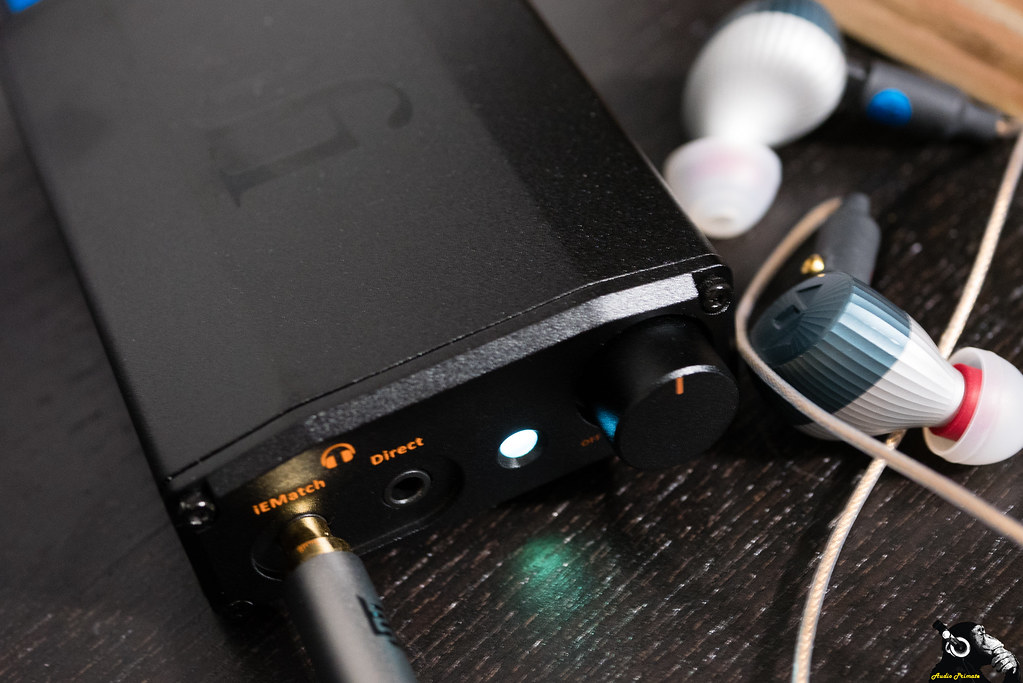
Usability: Form & Function
Unboxing
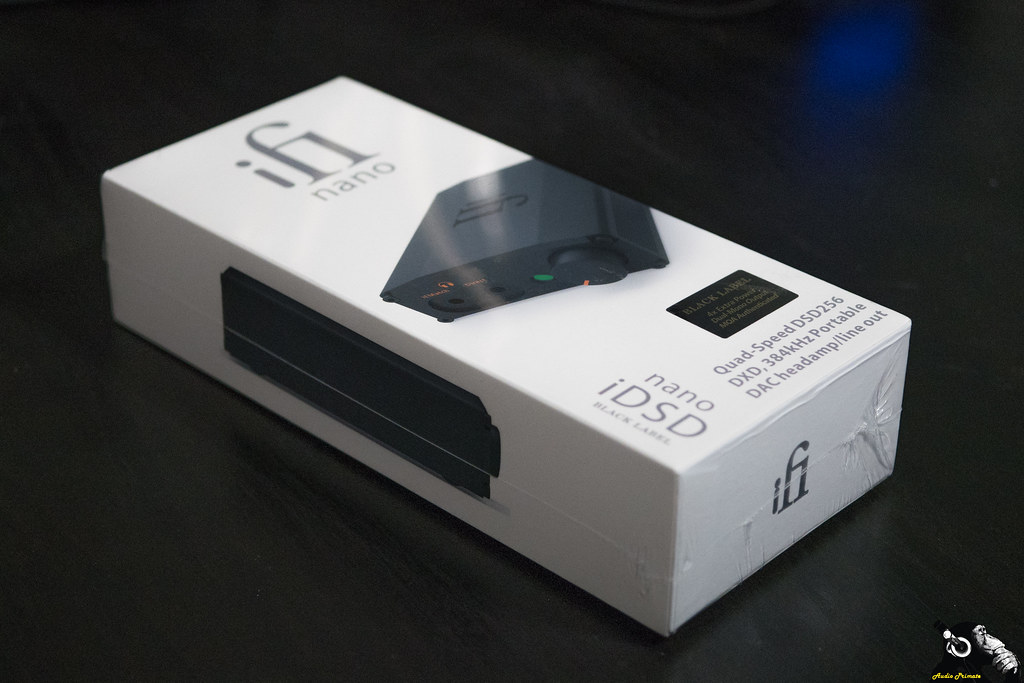
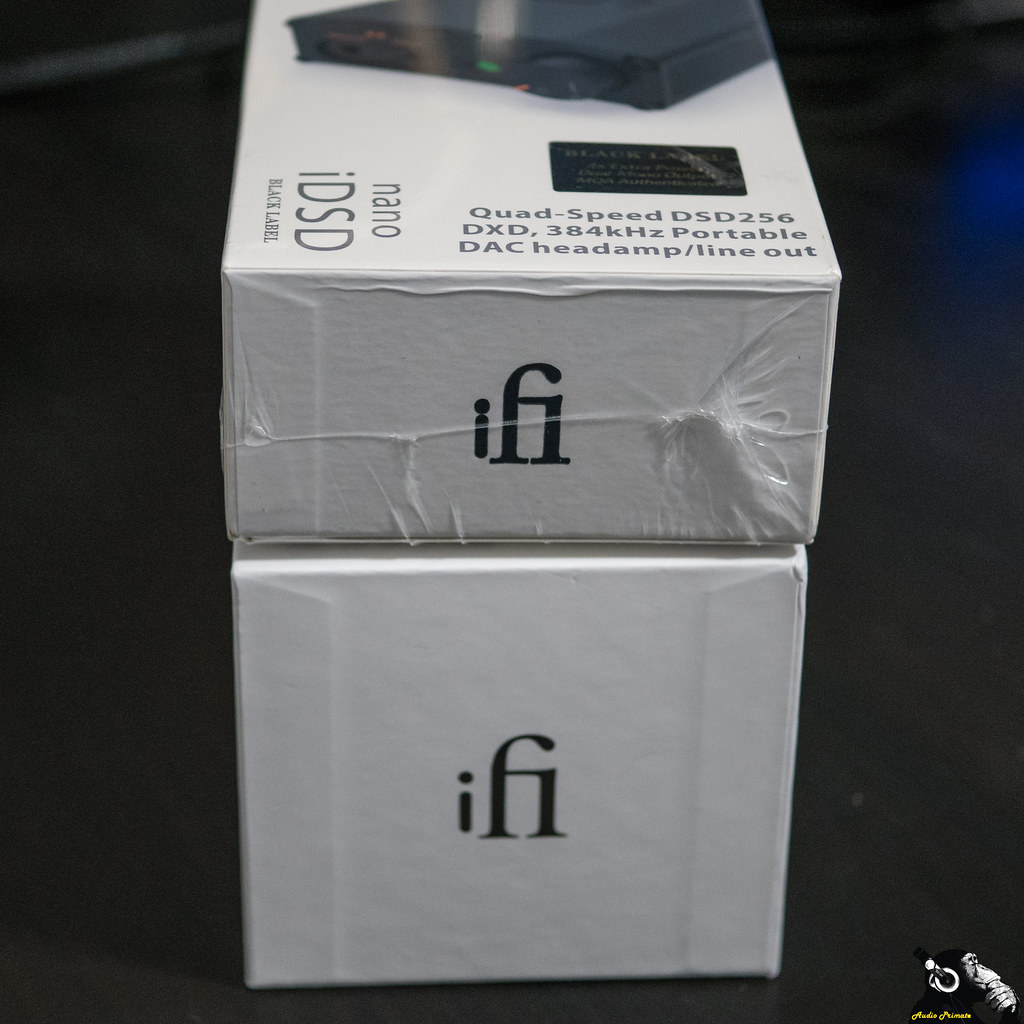 I’ve unboxed a lot of iFi gear over the years, but this is the first piece of gear from iFi to actually surprise me. Anyone who has been following iFi for any length of time or bought any of their Micro or Nano series DACs or amps has received the same box, with quite often the same components and compartments inside. It’s a roughly 10” x 3.5” x 3” oblong rectangle—a sort of less streamlined coffin-box. In the past, it hasn’t mattered whether you were buying a Nano or Micro series, the only thing different on the top level was how big the cut-away in the foam insert was. Below the presented DAC or amp would be some mix of the following accessories, a red 3.5mm aux cable, a short purple set of RCA interconnects, some adaptors (most likely), rubber stacking bands (for your DAP/phone), and a blue USB cable (sometimes USB3.0).
I’ve unboxed a lot of iFi gear over the years, but this is the first piece of gear from iFi to actually surprise me. Anyone who has been following iFi for any length of time or bought any of their Micro or Nano series DACs or amps has received the same box, with quite often the same components and compartments inside. It’s a roughly 10” x 3.5” x 3” oblong rectangle—a sort of less streamlined coffin-box. In the past, it hasn’t mattered whether you were buying a Nano or Micro series, the only thing different on the top level was how big the cut-away in the foam insert was. Below the presented DAC or amp would be some mix of the following accessories, a red 3.5mm aux cable, a short purple set of RCA interconnects, some adaptors (most likely), rubber stacking bands (for your DAP/phone), and a blue USB cable (sometimes USB3.0).
This time around we get a half-height box, which I very much like. The wasted space of previous Nano series boxes has been eschewed in favour of a more efficient DAC apartment. You’ve got your bed of foam on the left, and your closet box of white accessories on the right, all the cooking happens when the DAC gets out of bed. The box is still surrounded in a tight-fitting card sleeve, and still has the same silver iFi logo filigreed onto the top of the now slimmed down white heavy card box. Some things change, but others stay the same.
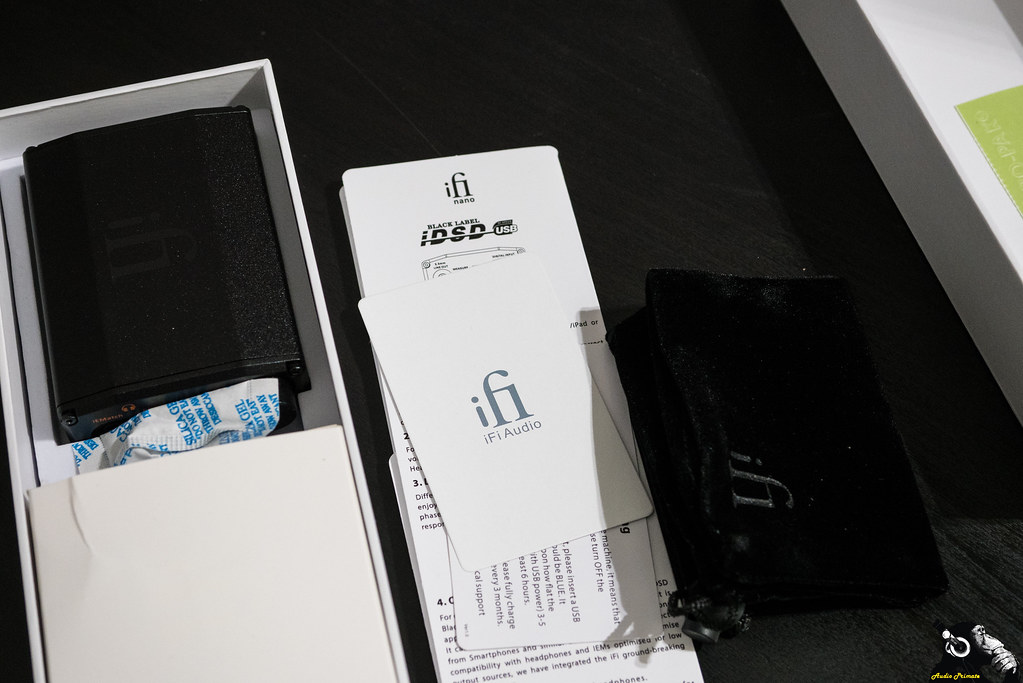 |
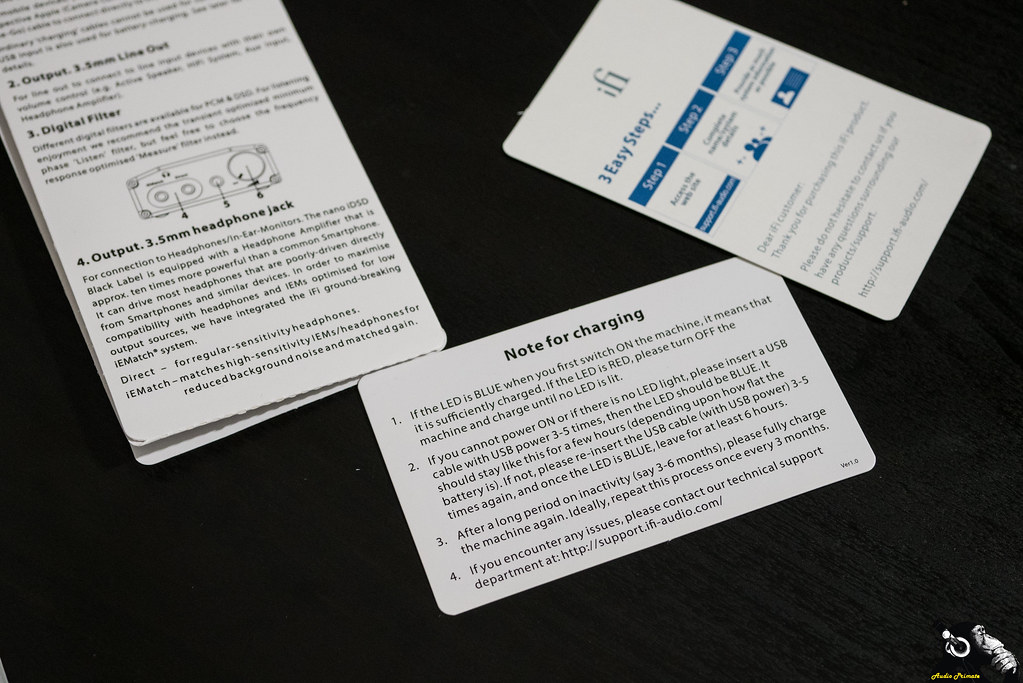 |
 |
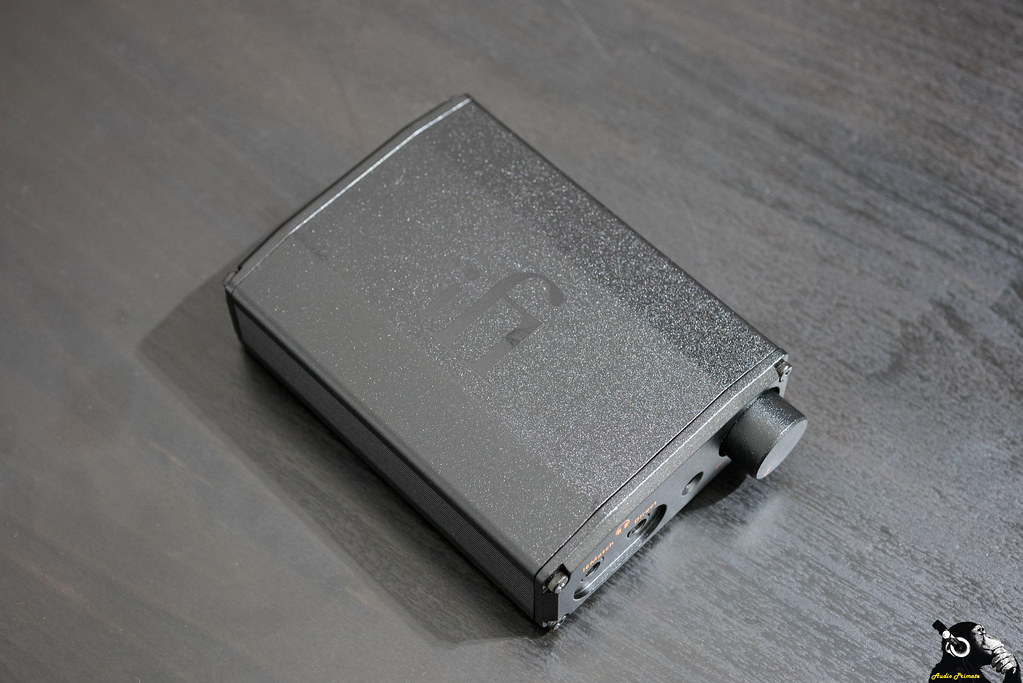 |
Aesthetics and Ergonomics
The major ergonomics critique of the iFi Micro series is that calling them portable is a bit of a joke. They are portable like your laptop and less convenient to carry, as there just aren’t any bags that really work for iFi’s unique signature shape. I loved the iFi Micro iDSD Black Label, but it was about as transportable and ergonomic as a pet brick. Don’t throw your Black Label, it’s so much better than Father Jack’s brick. It’s a shape that grows on you. Love who your Micro be, iFi.
That said, the Nano series is smaller, a little smaller than a minimum size deck of Magic the Gathering cards, with penny sleeves. Previous iterations of the iFi Nano series haven’t had any of the genetic make-up of the iDSD Micro Black Label in the looks and functionality department. Now that has changed. This isn’t your 2014 Nano iDSD. That version was silver, with big faceplates ridges on the front and back, whilst the new one has tapered edges to make it more pocket friendly. It doesn’t really feel like something you’d throw in your coat pocket due to the ergonomics. Those two RCA jacks sticking out the front and the coax coming off the back coupled with the aforementioned anodized aluminum ridges left lots of things to poke you from inside your jacket pocket.
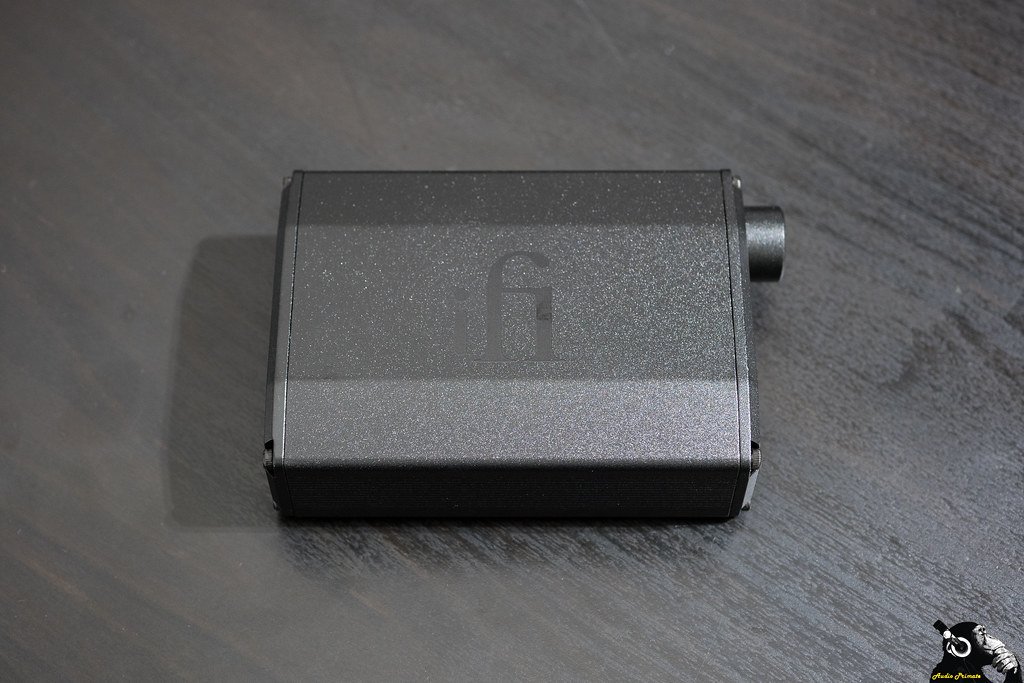
From an ergonomics perspective the new Black Label is smoother, sleeker, with more attractive printing and a more durable frame. I say more durable for a different reason than one might think. It is made of the same aluminum, it has the same anodized finish (albeit in black), but it has some key differences. The iFi iDSD BL is rocking out with three 3.5mm jacks set flush and not directly by the volume knob. Making the 3.5mm jacks flush makes it so there isn’t anything to snag on, which is more pocket friendly. The placement of 3.5mm output right next to the volume knob didn’t just make the front of the original Nano iDSD a bit busy, it made it so turning the volume knob whilst listening to headphones would require navigating your headphone cable. An additional pocket friendly addition is switching from the USB B input of the original Nano iDSD to the USB A OTG input of the Micro iDSD series. The connection is very stable which reduces stress on the jack. All these smoothing factors add to reduced wear and friction on the case elements, and the more secure USB connection will minimise damage to the USB connection, meaning this is a daily driver that should hold up to a bit of rubbing, but I’d still not drop it or toss it around roughly.
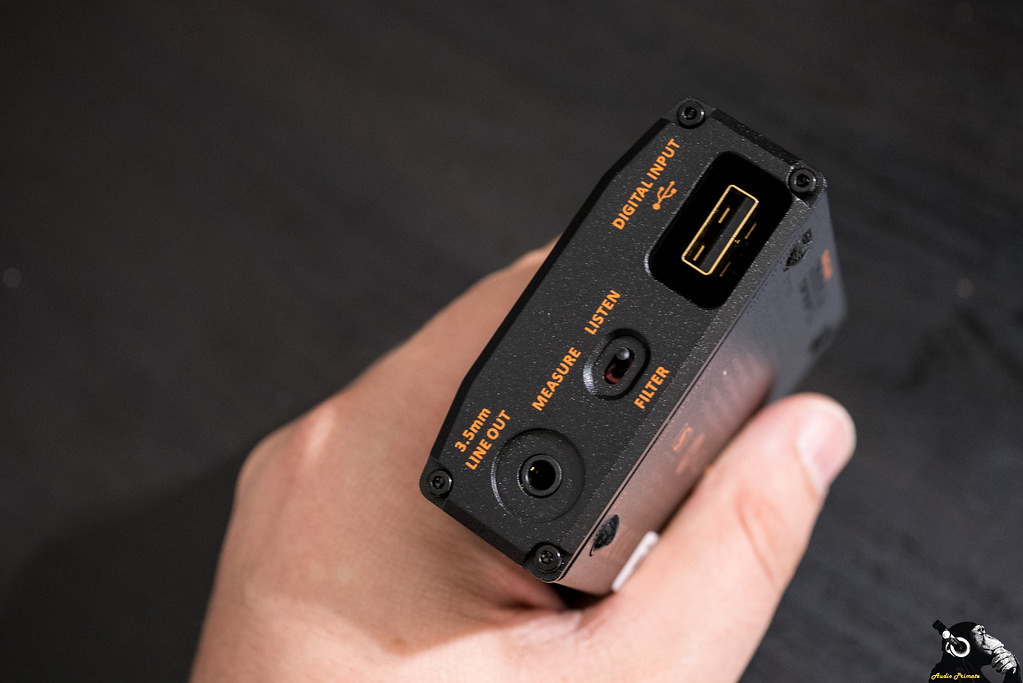
Function
The original iFi Nano iDSD was full of firsts (DXD and DSD256, super lightweight, 10 hour pure battery running) and was the best-selling DAC in Japan for a while, but it was for a different use case. That iDSD was about being a pint-sized capable home DAC with a lightweight amplifier that only output 130 mW into 16Ω. It had a digital out, and full-size RCA outputs to hook up to your home amplifier—great features, but not pocket friendly. The iFi Nano iDSD BL has some serious upgrades under the sleeker casing. Much like the Micro iDSD BL, this Nano iDSD BL has iEMatch built in and iPurifier built in. Like the Nano iDSD (original) the Nano iDSD BL runs on battery for 10 hours and throws down some DSD256 and DXD, but it also has MQA in-built now too.
MQA
Now, I’m not sure about this MQA thing (ars technical article that is well worth a read). Some have said it’s a sneaky backhanded route to a new form of DRM (record companies have to license equipment, consumers pay for special equipment, streaming services get charged for royalties, etc…). Whatever I might think about the likelihood that MQA gives me better than just streaming 24/96 FLAC directly or listening to real master quality PCM (Archimago’s Musings), MQA certainly didn’t sound bad. That said, I was listening through the XI Audio Formula S and a pair of HiFiMAN Susvara headphones with the Nano iDSD BL as the DAC to start. I listened to 2L recordings DXD tracks in both DXD and in the MQA down-coded versions. I don’t know if I would be able to tell the difference. Both sounded bloody excellent, but those are excellent recordings. Chicken/egg dilemma. Did the tracks sound excellent amd the format captured the quality of the recording, or would any lossless format of CD quality or above capture the quality of the recording? I don’t know. I also took an auditory stroll through Tidal’s ‘Masters’ library. Beyonce’s Lemonade album sounded awesome—why did Adele 25 win best album? That decision makes no damn sense as Lemonade is a triumph from start to finish (though some parts had some hardcore derivations, like the transparent Eurythmics inspiration on Don’t Hurt Yourself) and 25 is Adele singing three good songs plus some filler.
The difficult part of MQA listening is its hard to compare to actual redbook CD. I’ve always found that Tidal sounds a bit ‘enhanced.’ I’m convinced that there is DSP to make it sound a bit more vivid. Who’s to say this doesn’t also happen with MQA? Most of the albums that Tidal has MQA ‘Masters’ of, they also have standard ‘CD Quality’ versions. So I stepped right up and made a quick playlist of some stuff I’m familiar with:
- Nick Drake – Thoughts of Mary Jane
- Nick Drake – One of These Things First
- Counting Crows – Anna Begins
- Norah Jones – Shoot the Moon
- Beyoncé – Don’t Hurt Yourself
- Led Zeppelin – D’yer Mak’er
- The Supremes – Where Did Our Love Go
- Beck – Guess I’m Doing Fine
With Thoughts of Mary Jane the volume levels between the tracks aren’t the same. I have similar experiences on Counting Crows – Anna Begins. The Masters versions seem a little more restrained, but they also have a touch more depth to the sound, but this additional depth sounds like it is all in front of the stage. The stage sounds moved, not factually deeper. Turning down the volume on the HiFi version of Norah Jones – Shoot the Moon gives a good approximation of the Master. I am noting a bit more texture in the bass on the Shoot the Moon Master version. It sounds a bit fuller with rounder attack and decay. I think there may actually be differences, but that some of it is difficult to judge due to volume effects. I observe similar improvement in the kick drum on Beyoncé – Don’t Hurt Yourself. Well it’s either confirmation bias, or a trend, the bass on the Master version of D’yer Mak’er is more textured and rich. Transients in the cymbals also take on a bit more weight. Overall the sound is just a little weightier and more textured. On The Supremes – Where Did Our Love Go the Masters version is the louder version. Unfortunately two Where Did Our Love Go tracks sound so different, I’m pretty sure they aren’t from the same master. I can’t do a real comparison. This may end up being a problem for anything that has a remaster. Provenance is important, but it may be even more important on MQA albums as essentially they are having multiple operations done on the material. On Guess I’m Doing Fine slide guitar and bass sound a bit richer with fuller note edges without sounding fat. The bass sustains just a little bit longer.
So inconclusion (intentional), the results are inconclusive on MQA. With 2L songs off their test bench I couldn’t distinguish MQA from DXD Masters. On Tidal, MQA sounded generally a little quieter, but also sounded like the notes were a bit fuller and richer, especially in bass notes, which got some plus texture. I couldn’t discern any differences in sound stage. I didn’t do my tests blinded, but I also didn’t always know the order of tracks and was able to pick out the MQA track on a couple of occasions without having visual confirmation (D’yer Mak’er, Guess I’m Doing Fine), which could easily be random chance. Without repeated blind testing, the null hypothesis would be that I guess right 50% of the time. Two cherry-picked right guesses does not a strong observation make. How much do you trust my ears? How much do you trust your own? The next time I listened to D’yer Mak’er I guessed wrong. I also wasn’t consistent on Norah Jones – Shoot the Moon. I think I’d have to have perfect volume matching to have confidence in any comparisons over time.
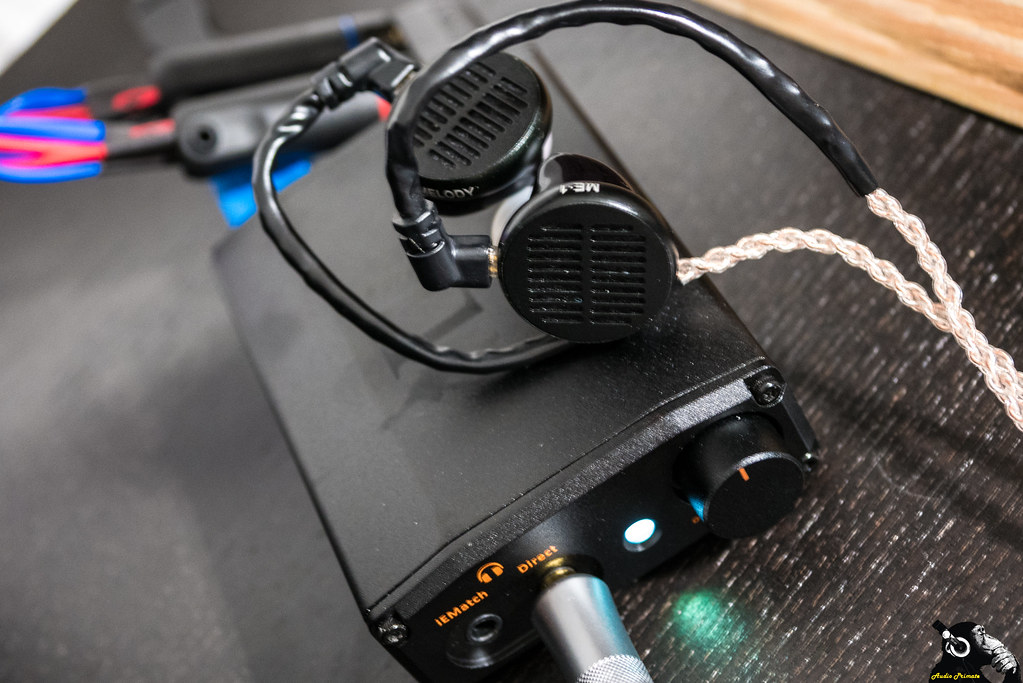
One thing I can say for MQA, it doesn’t appear to make sound quality worse. Whether real or imagined, the sound seemed different, but it seemed generally better than the CD quality version on Tidal and not worse than the DXD when listening to 2L tracks (with a substantially smaller file size). I’ve done previous tests with DXD and lower bitrate formats and found that I generally preferred the DXD to everything else and couldn’t tell it apart from DSD128 and DSD256 on DSD mastered tracks. Generally, DXD is as close to the master as you can get. Top masters are in 32bit DXD (352kHz), commercial DXD just drops 8 bits on the word length.
iEMatch

To test out iEMatch I whipped out my most sensitive IEMs, the Noble Kaiser Encore. When no music is playing there is low level hiss out of both the Direct and the iEMatch outputs, but the iEMatch output is virtually silent. The hiss on the iEMatch is way way down. Hiss is inaudible on either of them when any music is playing, including silent portions of music. The iEMatch comes with a sound signature toll. Because it raises output impedance (from under 1Ω to under 4Ω), it does exactly what you would expect it to do, it pushes up the bass a bit. The effect isn’t bad, but it definitely colours the sound.
On the Micro iDSD I found that the main advantage of iEMatch was allowing greater use of the volume control with sensitive IEMs, and this is still the case here. On Direct, the Noble Kaiser Encore gets loud fast.
Driving Power
As previously highlighted, the Nano iDSD BL does just fine with sensitive IEMs, thank you very much. It also handled the RHA CL750 with aplomb. But what about the HD600, you say? What about those teasers on the twitterverse?
The stats say it should be able to pull it off. I’ve previously done the HD600 driven well from a 280 mW into 32Ω source. That measurement just happens to be right about where this Nano iDSD BL sits (285 mW into 30Ω), so theoretically, it should do it.
Is theory replicated in practice? Absolutely. Actually, I think it drives the HD600 better than it drives the RHA CL750. When comparing to the XI Audio Formula S (in balanced output) fed by the Nano iDSD BL driving the HD600 vs. the Nano iDSD BL in Direct drive mode, I get a little bit more depth on the Formula S, but the differences aren’t much. The iFi Nano iDSD BL gets out some serious performance. It will drive the HD600 to plenty of volume with plenty of dynamics.
For laughs, I hooked up the HiFiMAN HE1000 v2 for a little try. The Nano iDSD BL gives enough volume, but it lacks the dynamic punch of the XI Audio Formula S and can’t match the imaging. Unsurprisingly, the HE1000 v2 needs more juice to thrive. You can play the HE1000 v2, but it’s wasted on the iFi Nano iDSD BL. It was, surprisingly, not a laugher.
I also used the 3.5mm out to the XI Audio Formula S (review upcoming), and it provided a super clean output. The system is straight up transparent. I loved this combination with the HiFiMAN Susvara, and I also dug it with the Unique Melody ME1.
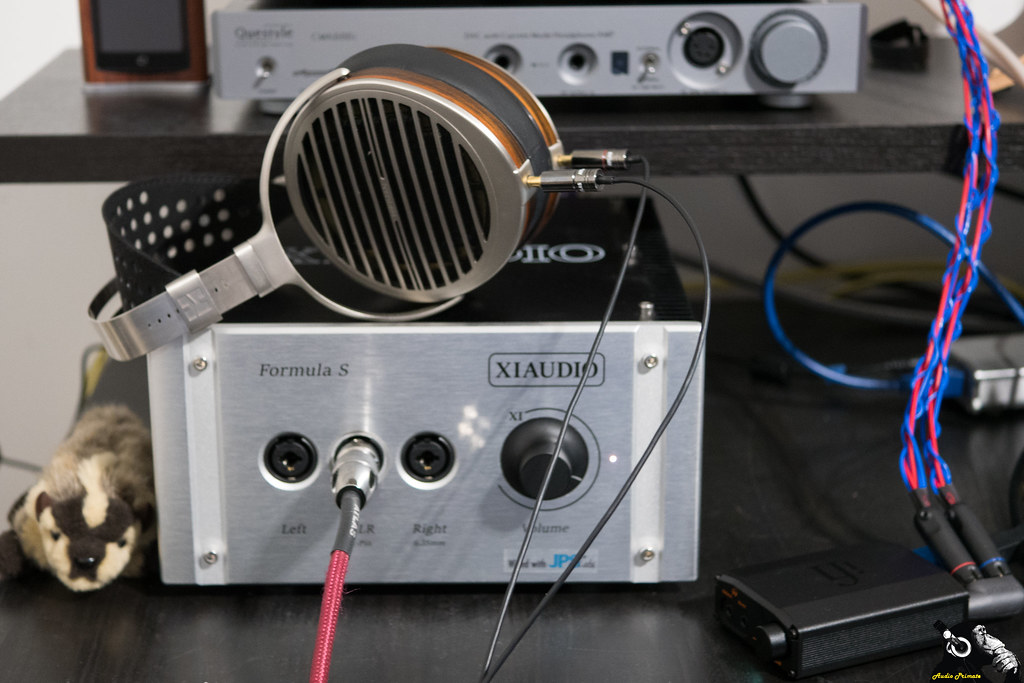
Audio quality
You know what is really strange? I really don’t have much to say about the sound quality of the iFi Nano iDSD BL independent of comparisons. It is transparent. It has excellent resolution. It doesn’t output a coloured sound. It has an accurate, well-defined, reasonably sized soundstage. I think the key here for the BL is actually how it compares to other DAC/Amps and DAPs. I’ve got a few of those on hand. DAC comparisons used the following signal chain, designed to get the best out of a DAC (you may not get as good using these on your rig):
Dell Inspiron 13 → Generic iFi USB3.0 cable → iFi Micro iUSB3.0 → LH Labs Lightspeed 2G split power and data usb cable → DAC/Amp (potentially with adaptor first)
I used a Lindy USB3.0 B to A adaptor instead of the iFi one included in the packaging (one more thing to send back to iFi in perfect condition). Since iFi doesn’t produce their adaptors and they don’t appear to be audiophile grade, it doesn’t really matter which adaptor I use, so long as it isn’t junk. I’ve used the Lindy for a long time. It does the job.
All comparisons were done using the Ultimate Ears Reference Remastered (for general timbre and DAC capabilities), the Sennheiser HD600 for driving power, and the Noble Kaiser Encore for hiss. Volume matching was performed using an SPL meter and a listening level of ~78.2 dB calibrated with white noise for comparisons using the UERR. I didn’t bother to volume match the Noble Kaiser Encore because the listening tests were for answering relatively simple yes/no question does it hiss during silence or during quiet music? For that question I just need to listen at a similar volume, not a precisely calibrated volume. For the HD600, my question was similarly simple to the Noble Kaiser Encore: can the player drive it? To know this, all I needed to do was check volume and listen for dynamics and spacialization. My listening level is 78.2dB, approximately, and I can usually get within 0.2-0.5dB by ear. I’ve had a goodly number of times where I set the volume on an IEM, measure it, and then discover that the SPL measurement is 78.2 dB with white noise. For all listening tests the Nano iDSD BL was on the ‘Measure’ filter.

I played the following tracks:
- Cyndee Peters – House of the Rising Sun (fantastic track from Opus3 records, DSD128)
- Hoff Ensemble – Blågutten (2L track with huge space, DXD, available for free)
- Wager-Åstrand – Fasten Seat Belts (another Opus3 track, DSD128)
- Pixies – Where is My Mind (24/88.2)
- Why? – Sod in the Seed (16/44.1)

iFi Nano iDSD BL vs. LH Labs GO2A Infinity
From a features standpoint, the Nano iDSD BL has a number of advantages: it draws normal current off of a USB source (LH Labs Draws a bit extra), it has 10 hours of battery, and it has a true and excellent fixed line-out. The Nano iDSD doesn’t have a balanced output, but the balanced circuit inside it gives the same sonic benefits. The Nano iDSD BL is more matchable and doesn’t rely on external volume control.
UERR
The sense of space in both players is similar, with the GO2A Infinity having a slight advantage in height and width, but depth goes to the Nano. The GO2A Infinity has harder edges and more firm impact, but it can be sharp and unforgiving at times. The Nano iDSD BL is smoother and more forgiving, whilst the GO2A can be hard and sharp at times. The upper mids on the GO2A are sweeter, but can overheat at times. The iDSD doesn’t soar as much as the GO2A does on Where is My Mind, but it has more depth on Sod in the Seed and has an overall less exuberant sound. On Sod in the Seed, the high glockenspiel notes are a bit piercing on the GO2A, and more natural on the Nano iDSD BL. Treble is hiked up a bit, which is probably what creates some of the extra height in the GO2A sound, and more edgy impactful sound in the upper mids. The sound on the GO2A can become fatiguing with its exuberance, even if it is totally inspiring in a collection of moments. If the hard edges and exuberance irritate you even a little, the echo-chamber of your mind will get to you when the track playing back has what some would view as flaws. Some will find the exuberance inspiring and worthy of praise whilst others will be immediately turned off on the GO2A Infinity, the Nano iDSD BL doesn’t have these hard edges, it’s smooth. It is still detailed, but the treble isn’t enhanced, so no divisive screams.
Noble Kaiser Encore
Out of both the Direct and iEMatch outputs, the Noble Kaiser Encore sounds as special as it should. Hiss is effectively controlled on both outputs, but there is some minor hiss during silence on the Direct output. You may not even hear it. If the Kaiser Encore is hooked up to the iEMatch output, it gets a bass boost. Maybe you want a bit extra midbass, maybe you don’t. When using the Kaiser Encore on the GO2A Infinity, even at the lowest gain, it hisses like an Indiana Jones nightmare.

HD600
The HD600 is my stress test for portable players and the both of these players pass. The HD600 sounds full with all dynamics intact. Soundstage was not crushed and nothing sounded softened.
iFi Nano iDSD BL vs. Questyle QP2R
I know. This comparison is not really fair, right? The QP2R is more than 6x the price. As anyone who’s been around the block in audiophile-land more than once will tell you, the law of diminishing returns hits like crotch-punching circus dwarf. There are some features that the Nano iDSD BL has that the QP2R doesn’t: a fixed analog line-out, and iEMatch. Of course the QP2R also throws down some features that iFi doesn’t, mostly about being a DAP and not a portable DAC/Amp. They both rock 10 hour (tested) battery life and excellent sound.

UERR
The UERR has brilliant spatial presentation on both the Nano iDSD BL, it’s a friggin’ monitor after all. However, the QP2R has greater depth, width and height as well as better layering. The soundstage has an effortlessness to the separation of the instruments on the QP2R. It’s really friggin’ brilliant. Tonally, the Nano iDSD BL is a bit soft in the midrange, whilst the QP2R is more impactful and sharper. On Where is My Mind, there is more soar, more space, more layering. The QP2R is just superior with the UERR. Listening to other tracks affirms the findings.
Noble Kaiser Encore
The QP2R has hiss with the Kaiser Encore, more so on the balanced out. The hiss is lower and less obtrusive than that found on the GO2A Infinity when on single-ended output, but it is noticeable. I tried messing with some adaptors like the 75Ω impedance adaptor from DUNU or the UE Buffer Jack. The UE Buffer Jack reduces hiss by adjusting damping factor in favour of the IEM. It doesn’t cause frequency response modification like an impedance adaptor, but it does lower the hiss level, whilst not eliminating it completely in this case. The 75Ω adaptor eliminated the hiss, but messed up both the bass and the treble, making the treble thin and the bass flabby. The Nano iDSD BL is superior with the Noble Kaiser Encore. It has been my experience that none of Questyle’s gear plays well with multi-BA, sensitive IEMs. I’ve tried using the QP2R, the CMA600i and the CMA800R Golden Reference amps, and all have problems with the Noble Kaiser Encore. Questyle gear likes headphones and IEMs that have some impedance.
HD600
The Questyle QP2R likes the 300Ω Sennheiser HD600 headphones. The Questyle QP2R, on paper, shouldn’t drive the Sennheiser HD600, but current mode amplification is magic, and it somehow manages to drive it with space to spare on the settings dialled into high gain and high bias settings with the balanced output. I had to turn it up to 99 out of 120 on volume, which means plenty of overhead was still there.
With regard to the sound characteristics of the two players, the QP2R has a clearer and more forward midrange with stronger edges. The iFi Nano iDSD BL has a smoother more soft feel, which makes it feel a little less resolute, but will have people really digging the ambiance once they settle in. Much like the Hidizs AP200 below, the Questyle QP2R has greater impact to it’s sound, but it never sounds like it is trying too hard or tipping the frequency response out of balance. The Questyle QP2R is delightful, and I prefer it’s sound to the iFi Nano iDSD BL. It is 6x the price, though, so on a value for money level the Nano iDSD Black Label wins easily.
iFi Nano iDSD BL vs. Shanling M2s
The iFi Nano iDSD BL and Shanling M2s might be considered direct comparators. Both do DSD256 and DXD. Both are small and capable. Both are useable with your phone (iFi via USB OTG, Shanling M2s via Bluetooth). Both can be used as external DACs with a computer. Both are under £200 with the iFi Nano iDSD Black Label coming in at £199 and the Shanling M2s dropping in at £189 (on Amazon.co.uk). The Shanling M2s has the best screen on any DAP I’ve been privileged enough to use. The Nano iDSD BL doesn’t have a screen, but does have iEMatch, a true fixed line-out and MQA.
UERR
The Shanling M2s has a softer midrange on the The Pixies – Where is My Mind and doesn’t soar with female vocals like the iFi Nano iDSD BL can in Where is My Mind. It lacks the amplitude. On Why? – Sod in the Seed the midrange is cleaner and clearer with better defined edges on Yoni Wolf’s slacker rap musings. Claps and woodblocks lack the impact and definition on the Shanling M2s. Bass on the Shanling M2s is a bit more present with a warmer overall sound. There is a bit of a gauziness to the Shanling M2s sound, a slight veiling. On the fast percussion of Fasten Seat Belts, the M2s just can’t keep up with the track in the way that the Nano iDSD Black Label does. The Black Label has excellent speed and precision. The Shanling M2s just sounds slower. Listening with the iFi Nano iDSD BL on Cyndee Peters – House of the Rising Sun, it’s like a morning mist has been pierced by the rising sun and forced to retreat back into the wooded hollows from whence it crept. The background is black and clear. Excellent. The Shanling M2s, whilst good doesn’t have the kind of clarity and resolution that the iFi Nano iDSD Black Label can muster.
Noble Kaiser Encore
There is a slight elevation in the bass on the Shanling M2s because of the output impedance. Some will like this ‘enhancement.’ The added bass is still nice, but this is not neutral playback. The Noble Kaiser Encore does not hiss on the M2s.

HD600
The Shanling M2s can play loud enough with the HD600 only if you max out the volume meter. This player will do in a pinch, but really shouldn’t be used for the HD600. Dynamics are crushed a bit and the soundstage gets a little smaller, but the overall sound is still good.
iFi Nano iDSD BL vs. Hidizs AP200
Interestingly both the Hidizs AP200 ($299 suggested for aluminum 32GB) and the iFi Nano iDSD BL ($199) have balanced amplification inside with a single ended output. The Hidizs is more expensive, but you do get yourself a full-on touch screen DAP with full Android, Play Store, and friggin’ killer sound. In practice the iDSD gets better battery life. I’ve been averaging around 7-8 hours on the Hidizs AP200.
UERR
On Where is My Mind, the Hidizs soars a little more and has a little more impact. It is a very punchy player without having the sharpened treble claws of the LH Labs GO2A Infinity. Image size and clarity are pretty similar between the Nano iDSD BL and the Hidizs.
 If I had to give any edges, it would be that the Hidizs AP200 has a little bit more height and the iFi Nano iDSD BL has a little more width. Depth is even, as far as I can tell. Tonally the Hidizs AP200 is a little more bright. What listeners prefer will really come down to tonal preference. Overall presentation is a little more energetic on the AP200 than the iFi iDSD Nano Black Label. Again, whether you want a more relaxed sound like the iFi or a punchy stand up and get noticed sound like the Hidizs will come down to listening preference. Personally, I’d be happy to have both options. Sometimes you want more relaxing, sometimes you want energy. Are you feeling laconic today?
If I had to give any edges, it would be that the Hidizs AP200 has a little bit more height and the iFi Nano iDSD BL has a little more width. Depth is even, as far as I can tell. Tonally the Hidizs AP200 is a little more bright. What listeners prefer will really come down to tonal preference. Overall presentation is a little more energetic on the AP200 than the iFi iDSD Nano Black Label. Again, whether you want a more relaxed sound like the iFi or a punchy stand up and get noticed sound like the Hidizs will come down to listening preference. Personally, I’d be happy to have both options. Sometimes you want more relaxing, sometimes you want energy. Are you feeling laconic today?
Noble Kaiser Encore
There is a very soft hiss with the Hidizs AP200 that becomes inaudible in most music. Listening to Cyndee Peters do House of the Rising Sun with the UERR there is no hiss on the track, it’s clean as a surgical theatre. When switching to the Kaiser Encore, there is hiss on the track but it is light and may actually be the IEMs being more sensitive to the noise of the tape. The Cyndee Peters recording is a tape transfer direct to DSD, so it is possible that the Kaiser Encore could be picking up non-musical information from the recording method. The impedance output of the Hidizs didn’t cause any perceptible bass elevation, which is a pro in my book. Performance compared to the Nano iDSD in Direct mode is pretty similar, with slightly more hiss on the AP200.
HD600
Much like the Shanling M2s, it takes everything the Hidizs AP200 has to get to a good volume level on the HD600 (97 of 100). In this case, I think it sounds a bit better than the M2s. The soundstage has significantly less width and depth than the Nano iDSD BL, and the Nano iDSD BL clearly outplays on clarity, separation and driving power. It also handles the speedy percussion of Fasten Seat Belts with outstanding resolution that the Hidizs AP200 does not match. The Hidizs AP200 gives good tone, generally, but the technical capabilities of the Nano iDSD BL are superior. At times the Hidizs struggles and distorts on some low bass notes, whereas the iFi Nano iDSD BL withstands the assault of low bass notes without distortion. The Hidizs does have a bit more focus and slam in the mids, which could be due to slightly elevated upper mids compared to the Nano iDSD BL. Punchy like the talented Mr. McGregor.

iFi Nano iDSD BL vs. Aune M1s
The Aune M1s is quite simply one of my favourite DAPs to work with. It doesn’t change the sound of any IEMs I play with it. It stays out of the way, maintaining the most consistently neutral presentation of any of the DAPs in my stable (more than a few). It’s a simple beast, and it doesn’t have a ton of power for output or a ton of features. It doesn’t have a fixed line-out. It will not play the HD600. It does have balanced output. It also doesn’t mess with the sound of the Noble Kaiser Encore at all. I’ve spent a lot of time previously talking about the Aune M1s, so you can check out it’s review.
UERR
Listening to House of the Rising Sun, there is more width to the stage on the Nano iDSD BL than on the Aune M1s. Both keep a nice tone, but the Nano iDSD BL has a bit sweeter treble when the bells and cymbals come in, with a bit fuller presentation. The Nano iDSD BL is more technically accomplished.
Noble Kaiser Encore
The M1s is perfectly clear with the Noble Kaiser Encore. It is a beautiful pairing that lets the Encore shine. There is no hiss, and the bass isn’t elevated due to impedance mismatches.
HD600
Can’t do it. Sound is drained and feeble. Frequency response isn’t accurate either.
Specifications
| Specifications | |
| Price | £199 ($199) |
| DAC | Burr Brown |
| Formats Supported | DSD64-DSD256, DXD384/352.8kHz, PCM 44.1-384, MQA 88.2/96/176.4/192kHz filters |
| Filters | Listen (transient optimised minimum phase filter)
Measure (frequency response optimised filter) |
| Inputs | USB Type A “OTG” socket with built in iPurifier® technology |
| Battery Life | ~10 hours (tested) |
| Dimensions | 96 x 64 x 25.5mm |
| Weight | 139g (0.31 lbs) |
| Warranty | 12 months |
| Headphone Amplifier | |
| Outputs | Dual Mono 2 x 285mW Direct Drive, coupling capacitor free circuit
2 x 3.5mm outputs: 1 Direct and 1 iFi iEMatch integrated (for sensitive IEMs) |
| Max Output Level (<10% THD) | >3.5V @ 600Ω load (Direct; 20mW into 600Ω)
>2.9v @ 30Ω load (Direct; 285mW into 30Ω) >1.7V @ 15Ω load (Direct; 200mW into 15Ω) |
| Total Harmonic Distortion + Noise | < 0.005% @125mW/30R |
| Dynamic Range (DNR) | >109db (A-weighted) @ 3V (Direct)
>107db (A-weighted) @ 0.5V (iEMatch®) |
| Output Impedance | ≤ 1Ω (Direct)
≤ 4Ω (iEMatch) |
| Channel Separation | > 79dB @ 600Ω load (Direct)
> 79dB @ 15Ω load (Direct) |
| Volume Control | Analog 2-track Potentiometer with power switch, < 2dB tracking error – 40dB…0dB attenuation |
| Line Output | |
| Total Harmonic Distortion + Noise | < 0.004% |
| Dynamic Range (DNR) | >109db (A-weighted) |
| Output Voltage | 2.15V (±0.05V) |
| Output Impedance | < 240Ω |
| Channel Separation | > 99dB @ 1kHz |
| Jitter (correlated) | Below set test limit |
Conclusions
If you are looking for an upgrade to your two channel living room setup from something more basic, and potentially from something considerably more advanced—as a straight-up DAC the iFi Nano iDSD Black Label was superior to my Questyle CMA600i in the same signal chain (playing into the XI Audio Formula S feeding HiFiMAN Susvara); or you are looking for something that drives a wide variety of headphones with no problem, or maybe you are staring into the abyss of format wars like the potential impending ascendancy of the newest format darling (MQA), then you may want to check out the iFi Nano iDSD BL. The Nano iDSD BL drives headphones from the Noble Kaiser Encore (very minimal hiss that disappears with music) all the way up to the Sennheiser HD600 without distortion through the Direct port. In the case of the Noble Kaiser Encore, I did notice a little tonal change on the iEMatch port, that change was pretty similar to what I experience when listening to the Kaiser Encore out of the Shanling M2s, both sound good with the Kaiser Encore.
If I had to cite any weaknesses, it would be that sometimes the midrange can sound a little meeker than I expect. Some will find this of benefit, and I find it to be a very minor detractor that varies in infinitesimally small effects with the changing of my mood. This softening of the midrange is specific to the headphone amplifier component as the line-out maintains firm tone through the midrange when feeding the XI Audio Formula S.
You’d be hard-pressed to find a DAC/Amp combo at £199 ($199) with more features and better sound. Just as the iFi Micro iDSD Black Label was unfair to it’s competitors, the Nano iDSD Black Label should make some DAPs in the £200 range nervous. It’s got better sound quality than the all of my under $200 DAP stable, and kicks out sound on par to significantly better than some more expensive DAPs that I have or have played with.





Great review… impressively expansive and comprehensive
I would love your sound comparison to Dragon Fly Red (similarly priced) if you have one. I am trying to decide on the two. I currently have a HiFimann HE41XX (easy to drive). But I have the HD6XX coming via the last MassDrop (clearly will be harder to drive)
Thanks in advance
LikeLike
I’ve never been terribly impressed by the Dragonfly series, but they do fit a specific use case very well: they are ultra portable and use very little power. I don’t think they will drive your HD6XX. The Dragonfly has limitations due to not having a battery. It also only plays to 24/96 PCM. My phone is capable of playing more formats. The Nano iDSD Black Label is just a more capable device. It sounds like you’ll want some of those capabilities, so I’d spend the small bit of extra money to buy the better device.
LikeLike
Really excellent review, your “crouch shot” metaphor should go down as a classic in the annals of audio reviewing!
LikeLike
Thank you for your thorough and detailed review.
How would you compare “Nano iDSD Black Label” to “Micro iDAC2” and “Micro iDSD Black Label”?
Specially in the case of overall sound quality, sound signature and the ability to drive harder headphones.
Same here, I just bought an HD6XX and I want to choose between these 3 devices.
I just want to know which one has more satisfying and enjoyable experience and considering the value which one do you recommend?
LikeLike
The Micro iDSD Black Label has the best sound quality of the bunch and the most features, including iFi’s XBass and 3DSound features (bass boost and treble boost, eespectively). I found the iDAC2 to be a little bright but still good. Some may find it too bright. I think the Nano iDSD has better amplification, with a more neutral overall sound. It is also less expensive, can run off battery (iDAC2 needs USB power) and plays more audio formats.
The Nano iDSD Black Label is the best value of the bunch. It will also power your HD6XX beautifully.
I hope that helps. Best of luck in your audio journey!
LikeLike
Yes, that was most helpful. Thanks a lot. I think I’ll go with the Nano…
LikeLike
Thank you for your informative in-depth review. I’m currently torn between buying the iFi Nano iDSD Black vs the iFi Micro iCAN(the original, not the SE, can’t afford it) and would very much appreciate it if you could give me your recommendation on the basis of sound quality, amp power and their ability to drive power-hungry headphones.
Also seeing that the Nano iDSD Black doesn’t have 3DSound and XBass while the Micro iCAN does makes it harder for me to decide, does the Nano iDSD Black audibly lack bass, punch and soundstage compared to the original Micro iCAN or does it somehow compensate satisfactorily without the XBass and 3DSound sticks?
Thanks for your patience.
LikeLike
Hi Alex, thanks for reading. The original Micro iCAN is excellent from my brief listen. I don’t have it to hand. I tried the HD600 on it and the XBass was just about perfect for addressing what most think is the main limitation of the HD600 (1 click up).
The Micro iCAN isn’t without negatives: it is not really portable, it doesn’t have a DAC built in, functionally not much more powerful than Nano (400mW into 32ohm vs. 285mW into 30ohm), mains powered, no battery, no clean power built in, no IEMatch built in, and no MQA.
I think the Nano iDSD BL is the better device, but if you really want tone controls and can accept the limitations of the Micro iCAN, it’s a good unit.
LikeLike
Thanks a lot for your advice, cheers.
LikeLike
Hi, please can you compare in terms of sound quality and drive capability this amp and the Pocket class A amp from XRKAudio?
LikeLike
Hi Eduardo. Unfortunately the XRK Pocket Class A and Nano iDSD Black Label are separated by the Atlantic Ocean. The XRK is in Wisconsin, USA and I’m in Manchester, UK. Sorry I can’t be more helpful.
LikeLike